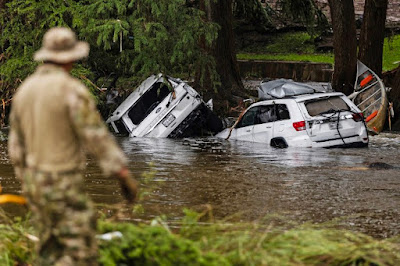🇺🇸 Texas Flash Flooding Turns Deadly: What Happened?
The weekend of the Independence Day holiday (July 4–5, 2025) was one of the most devastating natural disasters in Central Texas in decades. Heavy rains—totaling up to 12 inches in just a few hours—created catastrophic flash flooding in the Hill Country, most notably, Kerr County, San Antonio, and the Guadalupe River basin.
In some instances, within 45 minutes, the major rivers rose over 25 feet, invading communities, demolishing homes, vehicles and lives. Flash Flood Alley has certainly seen its share of flooding disasters but this one surpassed even the worst-case scenario.
---
🕯️ Casualties and People Missing
At this time, reports indicate:
At least 82 people confirmed dead, with an additional 28 child fatalities.
41 missing, and many are feared to be swept downstream or trapped in isolated areas.
The worst devastation was in the vicinity of Camp Mystic, a popular summer camp for girls, where cabins and trailers were washed away in less than a day.
In an earlier unrelated event weeks prior, San Antonio experienced its own deadly flash floods, where 13 people lost their lives, most trapped in their vehicles that were submerged underwater.
⚠️ What Caused This Flooding to be So Damaging & Destroying?
What led to this disaster:
Geographical impact: The Texas Hill Country consists of steep areas and narrow valleys that convey water into small areas and create flash floods.
Incredible amount of rainfall: Meteorologists noted places received up to two or three times more rain than any model predicted.
Infrastructure and storm management: Drainage systems and flood barriers were overwhelmed or nonexistent.
Delayed warnings: Numerous residents said they never received any timely warning, which raises deep concerns about the gaps in emergency alert and proper communication systems.
Experts think climate change could be contributing to a greater frequency and intensity of storm systems in this region and beyond.
---
🚨 Rescue and recovery efforts made extraordinary progress under challenging conditions.
Rescue efforts were impressive:
More than 850 people were rescued, of which over 100 were airlifted from trees, rooftops, and flooded houses.
FEMA and state agencies were called in immediately; Texas Governor Greg Abbott declared a state of emergency, and then-President Trump provided immediate assistance for federal disaster assistance.
In addition, local communities and church groups began to help provide food, shelter, and emotional support.
🧩 Critical Issues Raised
This tragedy has shone an urgent spotlight on:
1. Weather forecasting systems: Why did some areas see late or no warnings?
2. Resilience of infrastructure: Are cities becoming more resilient to increasingly severe weather events?
3. Public awareness of safety: How many deaths took place when people tried to traverse floodwaters?
---
💬 What The Authorities Are Saying
FEMA has recognized the scale of the disaster and has begun damage assessments in order to plan for recovery.
Local mayors and emergency management coordinators are requesting updated alert systems and the need for flood control infrastructure.
Environmental experts are calling for improved water retention strategies and need long-term investment to address climate change-related disaster concerns.
🛡️ How You Can Stay Safe During Flash Floods
📢 Always follow official evacuation orders.
🚫 Never drive through moving or standing floodwater—as little as 6 inches can cause a vehicle to lose control.
🏞️ Move to higher ground immediately during heavy rains or flash flood warnings.
📱 Use NOAA alerts or apps like FEMA Mobile for real-time weather alerts.
---
🏷️ Hashtags:
#TexasFlood2025 #FlashFloodAlley #DisasterRelief #EmergencyAlert #HillCountryFloods #ClimateCrisis #FEMA #DeshDuniya




Comments
Post a Comment